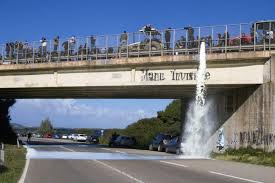Italy: Pouring milk on highways

Rome: The beautiful Italian island of Sardinia is outside the country mostly known for its Caribbean beaches, the crystalline water, its luxurious villas and the glamorous life.
However, in the past few weeks, Sardinia was all over the news for another reason. Photos of shepherds pouring milk on highways and town streets have been under the spotlight on social media. The act has given wide attention to the protest of farmers, who have been demonstrating against milk’s extremely low prices.
The shepherds accused cheese-makers and industrialists to have allied in order to keep prices for sheep and goat milk so low that they would rather throw the milk away than sell it for close to nothing.
The drop in prices is a consequence of the overproduction of pecorino romano cheese, the product in which most of the sheep milk produced in Sardinia goes to. The wholesale price used to be around €7.5 ($8.4) per kg, but it dropped to €5.5 ($6.2), bringing down the price of the raw material to the point production became unsustainable for shepherds.
Luca Saba, the president of the Sardinian Coldiretti, the association that represents agriculture, blamed the processing industries for the fall of prices, explaining that cheesemakers made much more than what the demand could absorb. Last September, the Italian center for agricultural studies already warned about the excessive production of pecorino romano cheese in 2018 and registered a surfeit of dozens of thousands of quintals. The crisis was not only triggered by a surplus in production, but also because of a significant decline in exports.
Massimo Forino, the director of the association representing dairy industrialists, told Italian media that pecorino romano cheese’s exports have fallen by 33% while production was raised by 23%, creating an economic imbalance in the sector. The most important market for the pecorino cheese has traditionally been North America, with the United States and Canada representing the biggest buyers of the Italian traditional product. However, in 2018 exports toward America fell by 44%, leaving cheese industrialists with a considerable surplus of unsold production. The drop in exports must also be traced back to the rise in prices. When the Italian pecorino cheese becomes too expensive, North Americans tend to go for a cheaper version of the product, like the one from South America.
As the protests got all the way over to Rome, with farmers demonstrating outside the Italian parliament, the government started working on a solution. The first proposal, that offered €0.70 ($0.79) per liter right away, with the goal of reaching €1 ($1.13) within three months, was rejected. As negotiations continue, the Ministry of Interior has allocated €44 million ($49.7m) to remove from the market all the excess of pecorino cheese to make prices go higher.
What is happening right now in Sardinia is somehow a classic conflict between the parts involved in the food supply chain. The final price of a product is set by the last subject in the chain, the retailer, that appoints it on the basis of the selling price of the processor, the intermediate category that transforms the raw material and delivers to the marketers. The profit that comes from a product often benefits mostly the seller and the industrialist, while producers, the first group of the chain, handle over the raw material at a price that can be extremely lower than the final one. Cyclically, this imbalance generates economical tension within the supply chain and the protests of Sardinian shepherds are the result of that tension. While negotiations are still on, this case is the opportunity for consumers, who only see the finished product and its ending price, to be more informed on the steps of the food supply chain, all the work’s phases and the labor struggles behind what they are buying.





